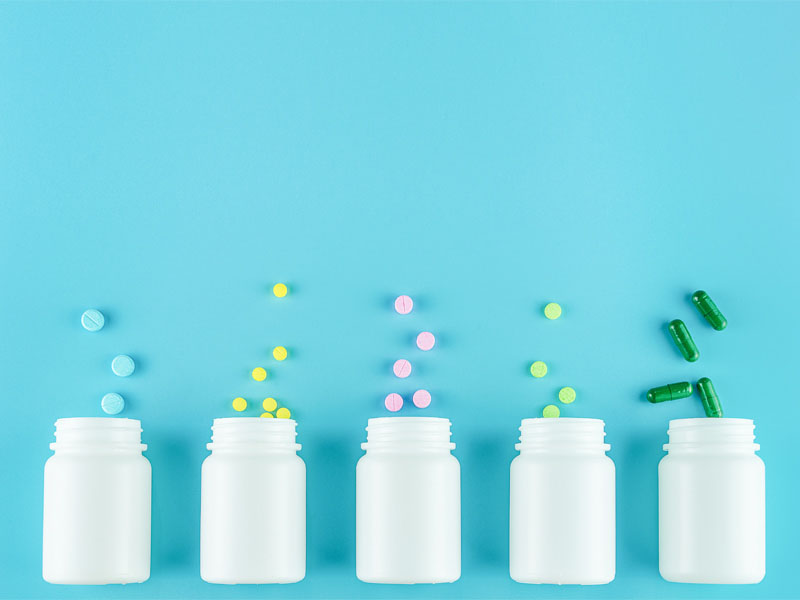More Topics
◀ Home
Opioid addiction awareness
Opioid misuse and addiction has caused an epidemic in the United States. According to the U.S. Department of Justice, 107,622 deaths in the U.S. in 2021 were due to a drug overdose. About 66% of those deaths were related to opioid overdose. Additionally, the Idaho Drug Overdose Prevention Program reported 241 deaths in Idaho were linked to an opioid overdose in 2021.
The effort to help cut down on opioid-related deaths starts with raising awareness and prevention.
 Facts about opioids
Facts about opioids
Learning more about opioids and how they work can help raise awareness of opioid abuse and overdose and bring attention to treatment options.
Here is some more information about opioids:
- Opioids are usually used for short-term pain control. They include medications such as fentanyl, hydrocodone (Vicodin®), morphine, codeine and oxycodone (OxyContin®).
- Opioids can be prescribed, but they can also be bought illegally. Even prescription opioids can be potentially dangerous and harmful if not taken as prescribed.
- Opioids are very addictive. The drug binds to receptors in the brain and nerve cells to reduce pain but can also cause a sense of euphoria or an intense high that can lead to dependence and/or addiction.
Opioid use disorder symptoms
Johns Hopkins School of Medicine describes opioid use disorder (OUD) as a complex illness in which people feel like they can’t stop taking the opioid drug, even when they want to stop, or when using it negatively affects their physical and emotional wellbeing.
Here are some of the symptoms of OUD:
- Physical dependence on opioids
- Unsafe, frequent or unhealthy use of opioids
- Cravings
- Isolation from family and friends
- New problems with personal finance
- Sudden weight loss
Treatment options
While there are effective treatments for opioid addiction, only about 1 in 5 adults with OUD will get treatment. According to the Food and Drug Administration (FDA), effective treatment includes a mix of prescription drugs with counseling and behavioral healthcare.
Medication therapy
There are three FDA-approved drugs that can help curb opioid dependence when combined with mental health treatment:
- Buprenorphine, which helps lessen the effects of physical dependence withdrawal symptoms
- Methadone, which reduces opioid cravings, withdrawals and the euphoric effects
- Naltrexone, which blocks the euphoric and sedative effects of opioids while reducing opioid cravings
Counseling and behavioral therapies
Cognitive behavioral therapy (CBT) can be a key part of an effective treatment plan when combined with medication. CBT can help people recovering from OUD in a few ways, including:
- Explaining how opioids affect the body and brain
- Helping people spot triggers that cause cravings and urges to use opioids
- Helping people build coping methods and skills to manage triggers
People recovering from OUD can have withdrawals, including anxiety, agitation and insomnia. CBT can help with this by teaching coping methods.
How you can protect yourself
If you are prescribed an opioid drug, here are a few things you can do:
- Ask your doctor and pharmacist to tell you when you are prescribed an opioid.
- Ask your doctor questions about why you may need to take an opioid and how long you will need to take it.
- Ask your doctor how you can lower your risk of potential side effects and what to do with any unused opioid medications.
- Take only the amount you are prescribed and follow your doctor's instructions. Only take them for the amount of time that your doctor recommends and prescribes.
- Do not save unused opioids and take any unneeded drugs to a drug takeback location. The Idaho Office of Drug Policy has an online search tool to help you find a drug takeback location near you.
Take precautions
If you know someone who is struggling with an opioid addiction, here are a few ways you can help:
- Educate yourself on the opioid epidemic. Learn about the causes, signs and symptoms of addiction.
- Talk about opioid addiction with family and friends. Share what you’ve learned about it, how it changes people’s lives and how to prevent it.
- Keep any medications you have at home out of sight and secure, especially opioids.
- Take advantage of national or local takeback days to safely get rid of any unneeded drugs.
How Blue Cross of Idaho is helping
Blue Cross of Idaho follows the Centers for Disease Control and Prevention's (CDC) rules for using opioids to treat chronic pain. Doctors have a series of steps they need to take when prescribing opioid drugs – especially for patients who haven't taken them before.
Here are a few of the steps doctors follow before prescribing opioids:
- Deciding when to start treatment with opioids
- Limiting the amount of days an opioid is prescribed
- Prescribing the right strength of opioids
- Using step therapy by requiring that non-opioids be tried before prescribing an opioid
Additionally, Blue Cross of Idaho has removed some of the financial barriers to getting naloxone, a drug that can help reverse an opioid overdose.
Helpful resources
If you or someone you know are struggling with mental illness or a substance abuse disorder, here are some resources that can help:
- 988 Suicide and Crisis Lifeline: Call or text 988
- Veterans Crisis Line: Call 988 and press 1, or text 838255
- For regional health crisis lines in Idaho, visit the Idaho Department of Health and Welfare’s website
- Substance Abuse and Mental Health Services Administration National Helpline: Call 800-662-HELP (4357) to get free, confidential 365-day-a-year treatment referrals and information (in English and Spanish) for mental and/or substance use disorders
For more resources on mental health, visit Blue Cross of Idaho’s mental and behavioral health education page.
Posted: August 30, 2023
